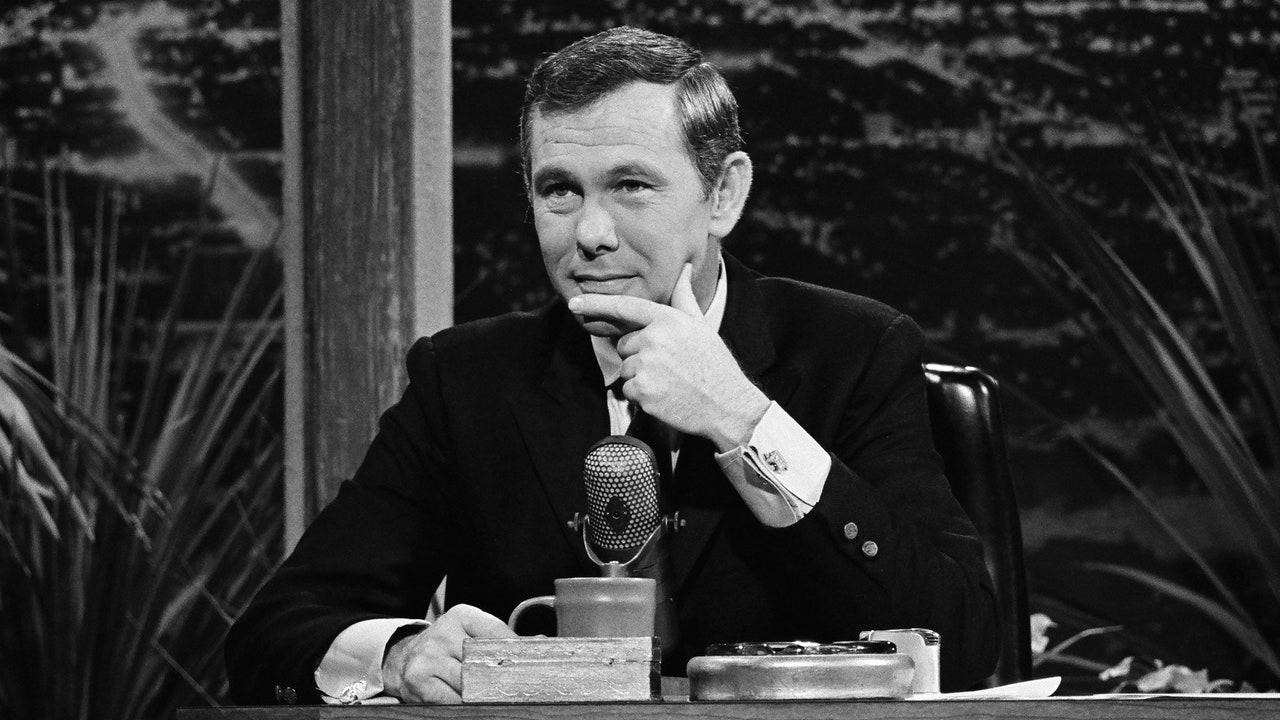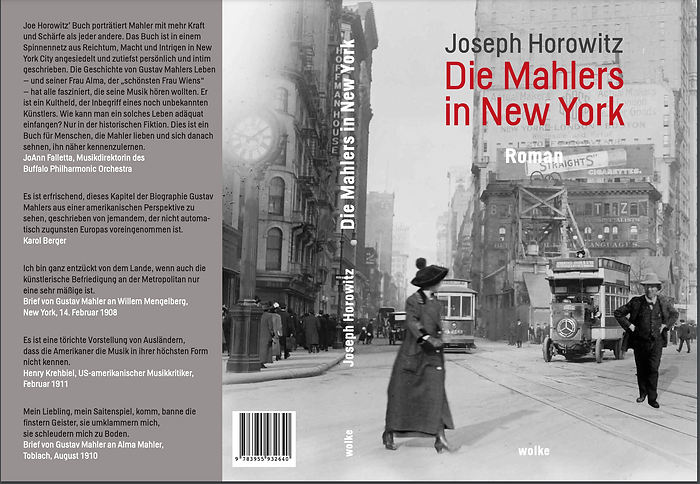For thirty years, from October 1, 1962, to May 22, 1992, Johnny Carson presided over American popular culture from the 11:30 P.M. throne of “The Tonight Show.” At its peak, the show was regularly watched by seventeen million people. (The current late-night ratings winner, “The Late Show with Stephen Colbert,” averages about 2.5 million viewers.) Together with his producers, Carson developed the format that network late-night talk shows would employ from then on: a monologue of topical jokes followed by a desk piece, and then a mix of guests and the occasional skit to round out the night. His monologue, which moved like a newspaper from major stories to sports, the arts, and human interest, and which never contained more than a few jokes on any one subject, became the template for all late-night opening monologues that followed.
Original ideas were not Carson’s forte: “The Johnny Carson Show,” the only major TV program he tried to launch from scratch, quickly failed, and after leaving “Tonight” he was unwilling, or perhaps, unable, to come up with a follow-up. But, as a host, he was an innovator. His style—both sartorial and, at least on camera, interpersonal—represented a new kind of cool: relaxed but quick-witted, generous but judgmental, controlled but possessed of an anarchic streak that he could deploy whenever bored or presented with second-rate material, or whenever anything on “Tonight” went wrong. His easygoing exterior belied a deft improvisatory mind that could take the temperature of the room, the guest, and the viewer all at once, course-correcting with breathtaking speed. As Kenneth Tynan noted when profiling Carson for this magazine, he learned early on that his real scene partner was not his sidekick, Ed McMahon, or his guests, or even the studio audience, but, rather, the cameras broadcasting him into America’s homes. He was so successful because his asides to the camera, his quick looks and devastating one-liners and wry smiles, enlisted viewers into a kind of conspiracy. Guests appeared on the show to promote their work, but Carson used them, sometimes quite coldly, as a vehicle to get to the millions watching at home. Fail to impress, and you’d find your allotted six minutes whittled down to two as Carson cut you off to go to commercials. One guest compared the experience to “facing death.”
Another major Carson legacy, besides the above, is the deliberate dumbing down of American television. As the comedian Mort Sahl told Tynan, “Carson’s assumption is that the audience is dumb, so you mustn’t do difficult things. . . . He never takes serious risks. His staff will only book people who will make him look artistically potent.” Carson, who was initially thought of as not intellectual enough for the job of hosting “Tonight,” was forthcoming about wanting no “controversy” on the show. The avoidance of controversy extended to politics; under Carson, who was liberal in his views, the monologues would be bipartisan in their targets, the content of the interviews studiously apolitical. This was a marked contrast from his sometime rival Dick Cavett, who often hosted in-depth conversations about ideas with guests, and was so open in his opposition to the Vietnam War that Nixon mentioned him in the White House tapes. By the time Tynan wrote about Carson, “The Tonight Show” was unlikely to convey a single idea that the audience did not already hold, and Carson had destroyed Cavett in the ratings.
Carson was influential in a third way, and that is with his choices of guests. To get a booking on “Tonight” was a career-making experience for a young comic, particularly if the host gestured to you to sit down on his couch after your set and kibbitz for a bit. The actor and comedian Drew Carey was so moved when describing the experience of his first appearance on “Tonight,” for PBS’s “American Masters,” that he teared up on camera.
And yet, for all this, Carson’s presence in American culture has been strangely ephemeral. Tynan noted that few outside the United States knew who he was in 1978, at the peak of his influence. Today, thirty-two years after his retirement, the number of people in this country who are aware of him is dwindling. As an experiment, I recently asked two friends—both writing teachers—to inquire of their twentysomething students what they knew about Carson. One friend happened to be workshopping a student’s short story in which the Carson-era “Tonight Show” figured prominently, but no one in his class apart from the story’s author had any idea who Carson was prior to reading it. The other friend struck out completely. Not one of her charges had ever heard Carson’s name.
When Carson retired, it was unthinkable that he would vanish into the mists of history within a generation. He had been crowning new stars, charming exotic animals, and soothing Americans to sleep night after night for three decades. So essential was he to the culture that when he moved “Tonight” from New York to Los Angeles, in 1972, it was like Peter the Great’s shifting of Russia’s capital from Moscow to Saint Petersburg. Just as Peter’s moving of his court transformed Moscow into a backwater for out-of-favor nobles, Carson’s helped to usher out the era when the Big Apple could claim to have cultural parity with Hollywood. Carson’s demand, during contract negotiations with NBC, in 1980, that “Tonight” ’s running time be cut to an hour led to the creation of a new time slot, with Carson getting a major say in its programming. Two years later, his protégé David Letterman was appointed to fill it. When Carson stepped down, he refused to nominate a successor; the resulting crisis led to the network late-night landscape we have today, with three duelling shows, all of which look an awful lot like “Tonight.”
Carson might have lasted longer in the public imagination had he not so deliberately retreated into the shadows. After he left “Tonight,” he shot a few cameos on shows such as “The Simpsons” and “Cheers,” called in the occasional monologue joke for Letterman to use, and contributed a couple of short humor pieces to this magazine, but never attempted any kind of second act. Unlike other elder statesmen who spend their late careers managing their legacies, Carson apparently didn’t care much about the history books, preferring instead to sail his yacht and learn Swahili. So happy was he to be out of the public eye that he granted only a single post-retirement interview, to the journalist Bill Zehme. Zehme, a writer for Esquire, had written about Carson many times and had taken to dropping by his office simply to see if he could catch a glimpse of the abdicated king. Those visits turned into a lunch, and that lunch turned into “Johnny Carson: The Man Who Retired,” which appeared in Esquire in June of 2002. For a profile of a man who does very little all day, it is remarkably fun reading, filled with the sentence-level panache for which Zehme, a self-styled heir to Gay Talese and Tom Wolfe’s New Journalism, was known. The piece’s central drama is not any dilemma in Carson’s life—it’s unclear whether Carson at this point had any—but, rather, what it feels like to eat lunch with your aging idol. In one of the piece’s most powerful passages, Zehme documents the changes in Carson’s speaking voice since his retirement. “Carson’s voice is different now,” he writes.
The passage is made all the more poignant when one recalls that Carson died, less than three years later, from emphysema.
After Carson’s death, Zehme began working on a biography of him, but the book progressed slowly. Zehme, like the historian narrator of Don DeLillo’s “Libra,” became so diligent in his Carson obsession that, rather than finishing his book, he collected binders and binders of material ranging from the important (interview transcripts) to the meaningless (an ugly necktie from Carson’s clothing line). In 2013, with three-fourths of the manuscript finished, Zehme was diagnosed with Stage IV colorectal cancer. From then on, until his death, in 2023, he set the book aside in order to focus on survival, both physical and financial. When Zehme died, it seemed that his Carson bio, the work to which he had dedicated so much of himself, would never be published. Instead, Zehme’s friend and former assistant Mike Thomas came in to finish the job.
Thomas, the author of quite a good biography of the comedian Phil Hartman, is a gifted writer in his own right, and he was the natural choice to take over the project—he first contacted Zehme, whose work he had read since high school, via a fan letter, and served as a kind of amanuensis to him for many years, helping to organize transcripts and do research, and working on biographies of Frank Sinatra and Andy Kaufman. But, perhaps because Zehme’s style cannot be imitated, or because Thomas had to work fast, or because he loved and idolized Zehme just as Zehme loved and idolized Johnny Carson, he appears to have left Zehme’s work completely untouched, and focussed solely on writing the final chapters of the story.
The resulting book, “Carson the Magnificent,” is an exquisite corpse. The first three-quarters is chronologically scrambled and written in Zehme’s fevered post-Tom Wolfe style, filled with parentheticals, italics, digressions, and sentences that rival Victor Hugo’s in length. Then, at the beginning of the sixth chapter, the book becomes a competently told, straightforward biography of the end of Carson’s life. What emerges from all this is less a portrait of Carson than a portrait of Zehme’s obsession with Carson. This is not necessarily a bad thing. Writers’ obsessions can illuminate their subjects in ways that more dispassionate approaches can’t. But, in this instance, Zehme’s compulsive overwriting and anti-dramatic priorities settle over Carson like a fog.
The biography’s theme is that Carson is essentially unknowable. As Zehme wrote in an e-mail to Michael Barrie, a writer for “Tonight” during the Carson years, his quarry “vexes me in countless ways . . . he was—like I need to tell you—the ultimate Interior Man, large and lively only when on camera. He was the inscrutable national monument on constant full view, ever occluded nonetheless.” In medieval England, the King had, as the historian Ernst Kantorowicz once explained, two bodies. There was his body natural—the one that loved, and ate, and suffered, and died—and then there was the body politic, the eternal guardian and embodiment of the English people. As many writers, beginning with Tynan, have noted, Carson the King of Late Night appears to have been similarly divided. There was the body natural, which was often neglectful, arrogant, shy, and, when drunk, impossible to deal with, and then there was the body television, which was charming, graceful, comforting, beloved.



